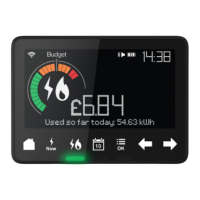
Do you have a question about the SMS smart meter and is the answer not in the manual?
| Voltage Range | 220-240V AC |
|---|---|
| Frequency | 50Hz |
| Ingress Protection | IP54 |
| Communication | GSM/GPRS |
| Display | LCD |
| Standards Compliance | IEC 62053-21, IEC 62052-11 |
| Current Range | 5-100A |
Details steps to protect equipment and manage energy supply interruptions during smart meter installation.
Provides advice on gas appliance safety, CO alarms, ventilation, and emergency procedures.
Offers guidance on electrical safety, appliance maintenance, and using registered electricians.
Reduce bills by shortening shower times and fitting tap inserts and aerating shower heads.
Adjust radiator controls in unused bedrooms to save energy.
Dry clothes naturally in the garden when sunny instead of using a tumble dryer.
Programme your boiler and set thermostat between 18-21°C for annual savings.
Save energy by turning off lights and appliances and avoiding standby mode.
Use full loads for washing machines, wash at 30°C, and boil only needed water.
Personalize your IHD by adjusting budget, brightness, night mode, alerts, language, and tones.
Look for soot, stains, or discolouration near appliances like boilers, gas fires, or water heaters.
Ensure gas flames are blue; yellow flames may indicate a problem.
Check for blocked air vents or chimneys to ensure proper ventilation for gas appliances.
Recognize symptoms like headaches, dizziness, nausea, breathlessness, collapse, or loss of consciousness.
Open windows, turn off gas appliances, leave the building, and call the Gas Emergency Line.
Install an audible CO detector and ensure gas appliances are regularly serviced by a Gas Safe engineer.